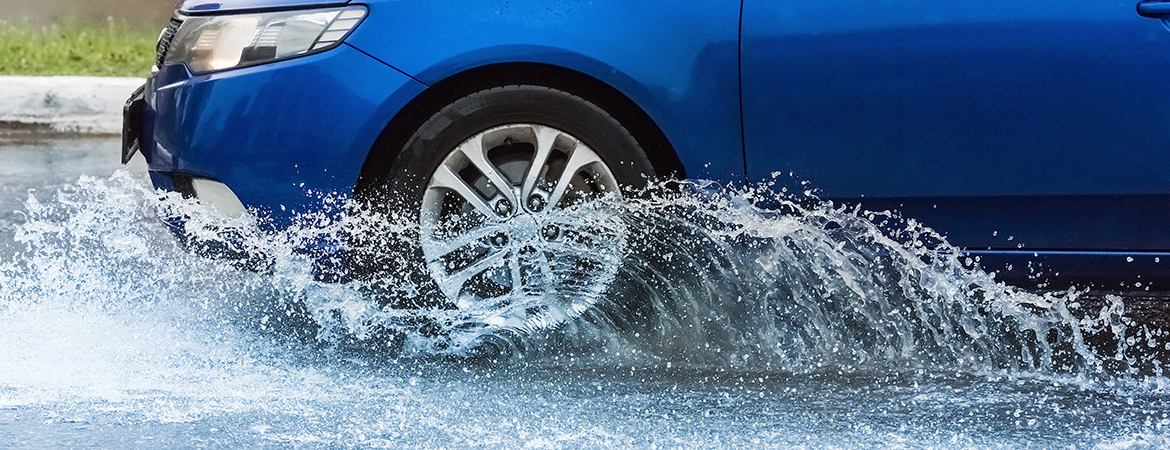Rainy day driving tips
A study on fatal crashes that occurred over a five-year span found that rain actually caused more driving fatalities than snow in 39 of the 50 states.

For the most part, the days of black ice and snowy roads are behind us, but don’t let your guard down! The rainy season is now upon us.
While a little rain may seem like less of a threat than winter slush, an analysis conducted by the Auto Insurance Center of the National Highway Traffic Safety Administration (NHTSA) shows otherwise. A study on fatal crashes that occurred over a five-year span found that rain actually caused more driving fatalities than snow in 39 of the 50 states.
Wet roads are cleverly dangerous—especially within the first half hour of rain—because all of that oil and grease resting on the road resurfaces.
The weather isn’t in your hands, but your safety is. Here are some things to keep in mind when the rain is pounding down and you’ve got somewhere to go:
1. Check the tread.
Tires with good tread are absolutely imperative when driving on wet roads. If tires are worn (or worse, bald!) the grooves aren’t deep enough to channel water out from beneath the tread. The result is hydroplaning, where the tread skims the water's surface and the vehicle no longer responds to the steering wheel. The effectiveness of wet-weather braking also decreases with tire wear.
The U.S. Department of Transportation recommends replacing tires when the tread reaches 2/32”. Luckily, checking tire tread is easy, as most tires nowadays have built-in indicators. These indicators are simply raised sections of rubber in the bottom of tread grooves that will appear when it’s time for a replacement.
If you want to check your tread the old-fashioned way, you can use a penny. Turn the penny so Lincoln’s head is pointing down and insert it into the tread. If the tread doesn’t cover his head, it’s time to go tire shopping.
2. Make sure your wipers are up to the task.
This may seem like common sense, but windshield wipers are the type of thing you don’t notice are broken until you need them.
Dirt, debris, and harsh sunlight all take their toll on wipers. Inspect them by lifting each wiper arm off the windshield and running your finger along the rubber edge. If the rubber is chipped or rough, it’s time for a replacement. Consumer Reports recommends a replacement about every six months. In addition to properly working wipers, glass treatments that “repel” rainwater can also help increase windshield visibility.
While inspecting the wipers, take a second to make sure the headlights and taillights are also working properly. Ensuring that others can see you may pay off in a heavy downpour.
3. Cruise control is a no-no.
Ah, cruise control… a road tripper’s best friend! Cruise control is a very helpful piece of technology most days… but on rainy ones, it’s best to forget it exists. Should you lose control of your vehicle on wet roads, cruise control complicates an already unfortunate situation.
Let’s think about this. If a vehicle hydroplanes, a driver is advised not to hit the brakes until they regain control of the vehicle. If the cruise control is engaged when hydroplaning, the vehicle continues trying to maintain a constant speed. Intuition tells the driver to tap the brake and kick off cruise control, but tapping the brake will only make the skidding more out of control – especially in a car without an anti-lock brake system. Needless to say, tapping off cruise control shouldn’t be something you need to worry about when a vehicle is out of control.
4. Stay calm if your car skids.
Do not panic! Take your foot off the accelerator and continue steering gently in the direction you want the car to go. Drivers often impulsively jerk the wheel in the opposite direction in these situations. This is very dangerous, for when the car begins to regain traction, it may be positioned to steer right off the road.
Instinct will probably also tell you to slam on your brakes—resist this temptation! This will only further upset the vehicle’s balance and make it harder to regain control.
>> We want you to be safe out there on the road… but accidents still happen.
At Kentucky Farm Bureau, we’ve got agents in all 120 counties. Click to find one near you.
